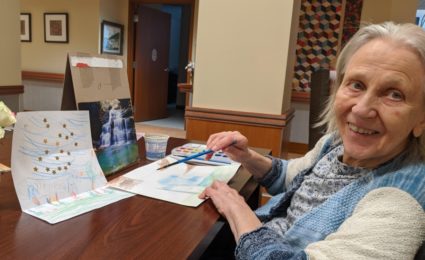
How art therapists are adapting during the pandemic
CLEVELAND — Like most aspects of life, art therapy is changing during the pandemic, leading therapists to devise new ways to serve their clients, who may be facing increased anxiety.
Art therapy combines verbal communication and art making to help people express themselves.
"I feel like I'm working nonstop now, because the need is so great for people to talk about their experiences, and their depression and anxiety," said Katherine Jackson, an art therapist and associate professor at Ursuline College in Pepper Pike, Ohio. "Things have escalated quite a bit for individuals during this time."
She's teaching classes and seeing patients virtually, using Zoom video conferencing. During the video sessions, Jackson still guides patients in art tasks, such as drawing, and asks them to tilt the camera to show her the progress. While she hasn't taken on new clients, she said there is a need to see people more regularly.
"I tried to see about 15 to 20 people a week before, and now I've been seeing about 30," she said.

Art Therapy Studio
Art Therapy Studio in Cleveland, a provider of individual art therapy sessions as well as on-site community programs, has also moved to online or telephone sessions, when possible, while some therapists on staff continue to go to hospital locations.
"We have a number of community partners that we actually haven't been able to service in the last two months because of the social isolation or social distancing," executive director Michelle Epps said. "We're trying to work with them now to figure out how we can bring our services to them remotely."
Cheryl Pete, the studio's clinical director, said therapists have been focusing on helping people cope during sessions.
"Just engaging in art-making actually is a really great coping skill," she said. "It helps people regulate their heart rate, regulate their breathing."
With people not visiting the art studio or accessing its materials, the therapists have been more creative about supplies for art-making. A post on Art Therapy Studio's Facebook page, for instance, shows people how to make glue at home.
"Whatever they may have access to, even if all they have is the back of an envelope and a ballpoint pen, we can work with that," Pete said.
While virtual art therapy is better than no art therapy, it comes with a variety of challenges. Those range from privacy issues, when your session takes place at home, to barriers of what the therapist can see on a screen.
"You don't pick up all of the nonverbal signals. You can't see as much body language as you would face to face with a person," Pete said.
Judson Senior Living
It's a much different situation at Judson Senior Living's independent and assisted living residences, where art therapy is still taking place in person, but not as it was before COVID-19.
"We've designed kits so everybody gets their own materials, made portfolios for everybody. So they keep their own artwork," said Cathy Bryan, coordinator of creative arts and art therapy at Judson retirement communities.
Residents have been without visitors due to the pandemic, and art has helped with the isolation, Bryan said.

"We've set up a partnership with a preschool. So we make art for them and they send us their art, which has been really fun," she said.
Whether putting a pencil to paper or rolling out clay, the physical component of art-making can be comforting, particularly while people stay apart.
"It's more of a need to have that connection and that touch. Even though we're not supposed to be touching, but they can touch the media," Bryan said.
This report originally appeared on ideastream.
Support Canvas
Sustain our coverage of culture, arts and literature.


















